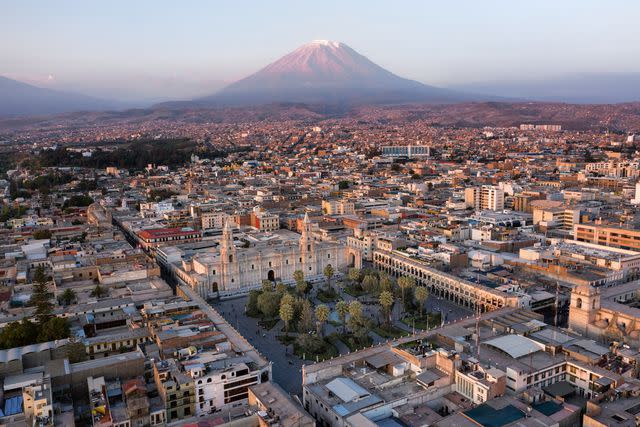I Hiked Past Slot Canyons and Ancient Ruins, Shopped for Cozy Alpaca Blankets, and Stayed at the Decadent New Hotels in Southern Peru
Here's how to visit Colca Canyon and Arequipa in Southern Peru.

From left: Oliver Bolch/Anzenberger/Redux; agefotostock/Alamy
From left: A condor soars above Peru's Colca Canyon; Mirador Cruz del Condor, a popular place to spot condors in Colca Canyon.Sunbeams spilled over snow-dusted hills into southern Peru’s Colca Canyon, sparking the morning migration of condors, earth’s largest birds of prey. At first, in that indigo hour, there was just a solitary bird. It surfed the thermals without ever needing to bat a wing, showing a grace and serenity that, upon closer inspection, belied its gawky face. Then three more condors careened into view, gliding up the yawning chasm so close to my cliff-top perch that I could feel their tailwinds.
Pre-Incan cultures viewed these birds as messengers of the gods, explained Vladimir Canazas, my guide from SA Expeditions. “The feeling of seeing these condors up close is so emotional that it affects me every time,” he said. I quickly understood why. The 40-odd condors nesting along this stretch of the canyon seemed oblivious to the crowds that, enchanted by their acrobatics, marveled from above. Just to the west of us, Colca Canyon plunged like an abyss, cleaving a scar into the Andes twice as deep as the Grand Canyon.

Pierre Lepretre/Getty Images
The city of Arequipa, with the Misti Volcano in the distance.Despite its beauty, few Americans have heard of Colca Canyon. For decades, the canyon and nearby Arequipa, Peru’s second-largest city, were off the radar for foreigners. But over the past few years, freshly paved roads have made the region easier to access, and the opening of several high-end accommodations has made it a comfortable perch for a few days of adventure travel.
I had come to Colca Canyon to hike past ancient ruins and even older terraced fields of potatoes, lima beans, and quinoa. Canazas and I trekked along dusty trails near the arid canyon rim to ruins like the Chimpa Fortress, a small citadel with panoramic views. We strolled the ancient paths of Uyo Uyo, a pre-Inca settlement that dates from the 14th century, where San Pedro cactuses now wrap around stone houses.
At night I relaxed at one of the 20 eucalyptus-shaded cottages at Las Casitas, a Belmond Hotel, Colca Canyon, which is located on an alpaca farm. (The grazing animals also serve as the property’s de facto landscapers.) At Curi?a, the hotel’s restaurant, I dined on risotto and artichokes before retreating to my outdoor heated plunge pool with a Sancayo Sour (pisco blended with cactus fruit) to soothe my sore muscles and scan the inky sky for the Southern Cross.

From left: Renzo Tasso/Courtesy of Peru Tourism; Courtesy of Belmond
From left: An alleyway at the Santa Catalina Monastery, in Arequipa; Las Casitas, a Belmond Hotel, Colca Canyon.After two nights in Colca Canyon, Canazas and I drove four hours south through the Salinas & Aguada Blanca National Reserve, where the wetlands brimmed with flamingos and skittish vicu?as, to Arequipa. Tucked between three towering volcanoes, it is often referred to as the White City because of the pale volcanic rock used in many of the colonial-era buildings. Since its founding in 1540, Arequipa has been a breeding ground for intellectuals and political rebels, including the novelist, Nobel laureate, and Peru’s most famous writer, Mario Vargas Llosa. (There’s even a house museum there dedicated to Vargas Llosa.)
As I walked Arequipa’s cobblestoned streets to the Santa Catalina Monastery, passing flowering courtyards and Baroque fa?ades, I couldn’t help feeling like I was in southern Italy rather than South America. Cirqa, a small Relais & Chateaux property that opened in 2019, has a European look to it. When I stepped into the vaulted lobby of this former monastery, I soaked in the hushed, ecclesiastical atmosphere as palo santo and muna, the Andean mint, wafted through the space. The 11 guest rooms are spare, but their heavy stone walls and iron chandeliers give them a feeling of grandeur. In the evening, the rooftop terrace was a lovely spot to watch as the mountain snowcaps turned amber in the lowering light.

Courtesy of Belmond
A guest room at Arequipa's Cirqa hotel, housed in a former monastery.Arequipa is the home of Peru’s booming alpaca industry, and I found cozy sweaters and blankets at shops like Kuna and Sol Alpaca, both just steps away from the hotel. The city’s food scene, meanwhile, was as unique as its character — UNESCO named Arequipa a City of Gastronomy in 2019. I tried chupe de camarones, a river-shrimp soup, and lamb ribs at local institutions like Chicha and La Nueva Palomino. The hearty fare would fuel my daily hikes into the verdant Chilina Valley and the slot canyon Quebrada de Culebrillas.
Three volcanoes lord over Arequipa like hulking giants: Pichu Pichu (18,583 feet), Chachani (19,872 feet), and Misti (19,101 feet). The latter is cartoonishly conical and notoriously feisty. “If Misti has a big eruption one day, we’ll all be dead,” Canazas said, eyes wide, when it first came into view on our drive into town. “We’ll become the new Pompeii overnight.” Heeding his warning, I set off on a solo mountain-bike trip down Misti’s placid neighbor, Pichu Pichu, on my last day. The descent was more than 3,000 feet. I zigzagged on a single-lane road from the scrub-covered summit into terraced lowland fields below. All the while, the setting sun morphed from amber to gold. In those fleeting moments of free fall, I imagined that I was one with the condors. I soared, with as much grace as I could muster, and wound my way back home.
A version of this story first appeared in the October 2023 issue of Travel + Leisure under the headline "Peak Peru."
For more Travel & Leisure news, make sure to sign up for our newsletter!
Read the original article on Travel & Leisure.
